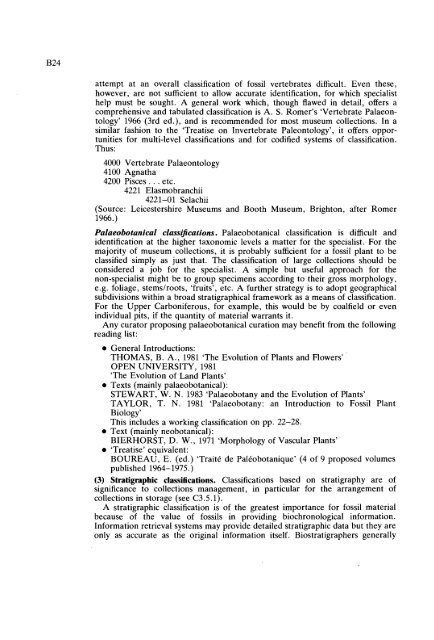GUIDELINES FOR THE CURATION OF GEOLOGICAL MATERIALS
GUIDELINES FOR THE CURATION OF GEOLOGICAL MATERIALS
GUIDELINES FOR THE CURATION OF GEOLOGICAL MATERIALS
Create successful ePaper yourself
Turn your PDF publications into a flip-book with our unique Google optimized e-Paper software.
attempt at an overall classification of fossil vertebrates difficult. Even these,<br />
however, are not sufficient to allow accurate identification, for which specialist<br />
help must be sought. A general work which, though flawed in detail, offers a<br />
comprehensive and tabulated classification is A. S. Romer's 'Vertebrate Palaeontology'<br />
1966 (3rd ed.), and is recommended for most museum collections. In a<br />
similar fashion to the 'Treatise on Invertebrate Paleontology', it offers opportunities<br />
for multi-level classifications and for codified systems of classification.<br />
Thus:<br />
4000 Vertebrate Palaeontology<br />
4100 Agnatha<br />
4200 Pisces . . . etc.<br />
4221 Elasmobranchii<br />
4221-01 Selachii<br />
(Source: Leicestershire Museums and Booth Museum, Brighton, after Romer<br />
1966.)<br />
Palaeobotanical classiJications. Palaeobotanical classification is difficult and<br />
identification at the higher taxonomic levels a matter for the specialist. For the<br />
majority of museum collections, it is probably sufficient for a fossil plant to be<br />
classified simply as just that. The classification of large collections should be<br />
considered a job for the specialist. A simple but useful approach for the<br />
non-specialist might be to group specimens according to their gross morphology,<br />
e.g. foliage, stems/roots, 'fruits', etc. A further strategy is to adopt geographical<br />
subdivisions within a broad stratigraphical framework as a means of classification.<br />
For the Upper Carboniferous, for example, this would be by coalfield or even<br />
individual pits, if the quantity of material warrants it.<br />
Any curator proposing palaeobotanical curation may benefit from the following<br />
reading list:<br />
General Introductions:<br />
THOMAS, B. A., 1981 'The Evolution of Plants and Flowers'<br />
OPEN UNIVERSITY, 1981<br />
'The Evolution of Land Plants'<br />
Texts (mainly palaeobotanical):<br />
STEWART, W. N. 1983 'Palaeobotany and the Evolution of Plants'<br />
TAYLOR, T. N. 1981 'Palaeobotany: an Introduction to Fossil Plant<br />
Biology'<br />
This includes a working classification on pp. 22-28.<br />
Text (mainly neobotanical):<br />
BIERHORST, D. W., 1971 'Morphology of Vascular Plants'<br />
'Treatise' equivalent:<br />
BOUREAU, E. (ed.) 'Trait6 de PalCobotanique' (4 of 9 proposed volumes<br />
published 1964-1975.)<br />
(3) Stratigraphic classifications. Classifications based on stratigraphy are of<br />
significance to collections management, in particular for the arrangement of<br />
collections in storage (see C3.5.1).<br />
A stratigraphic classification is of the greatest importance for fossil material<br />
because of the value of fossils in providing biochronological information.<br />
Information retrieval systems may provide detailed stratigraphic data but they are<br />
only as accurate as the original information itself. Biostratigraphers generally

















